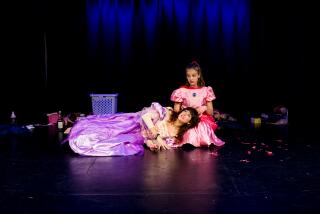FRINGE FEST, DANCERS OUT OF STEP
- Share via
Three weeks ago, Aaron Paley, director of the Fringe Festival/Los Angeles, mailed out 4,000 applications inviting members of the local arts community to take part in the multimedia, countywide arts festival planned for September. So far, he’s only gotten one entry form back.
Paley’s not worried. He predicts his mailbox will be full by the June 1 sign-up deadline.
But he’s not apt to get an abundance of applications from the local dance community: Many of its members have expressed serious concerns about the way the festival is set up (participants are required to pay at least a $100 fee in order to perform and must pay their own production costs), and some flatly refuse to participate at all.
“Personally, I’m outraged,” said Anthony Shay, director of the Avaz International Dance Theatre, which will skip the festival. “For one thing, there’s no quality control. All you have to do is pay money to get in it.”
Coming up with the money in the first place worries Katja Biesanz, director of Katja Biesanz/Dance Theater: “We’d be glad to support it (the festival) if there were more support for dance generally in the city, but it’s an enormous struggle” just to survive.
The Fringe, modeled after the Edinburgh Festival Fringe of Scotland, was designed to feature smaller local arts groups and individual artists, running concurrently with and complementing the Los Angeles Festival (Sept. 3-27). The main festival will spotlight 31 national and international arts groups; Paley said he expects the Fringe to offer about 200 events. Los Angeles Festival participants will be paid from a $5.8-million budget; Fringe artists must pay their own way.
The situation puts a heavy financial burden on local dance companies, most of whom--unlike most local theater groups, for example--do not own their own performance spaces. In order to perform in a formal setting during the Fringe Festival, the dance companies would have to rent facilities, as well as pay for stage technicians and for dancers’ rehearsal and performance fees.
“It costs a lot of money to self-produce in L.A,” said Linda Sohl-Donnell, director of the LTD/Unlimited Dance Company. “To incur that expense and then compete (for audiences and reviews) with the major festival is not smart. I can’t take that financial gamble--especially because we have a concert coming up this November.”
Even so, Sohl-Donnell said she would like to participate in the Fringe and may present an open rehearsal or workshop during the festival, but will not mount a regular LTD program of tap dance.
Paley said he “knows the reluctance of the dance community is out there. They tell me ‘we do one big concert a year, and can’t afford another one.’ ” In response to this, Paley said he’s been advising the dance groups to “scale it down” by presenting works in progress or perhaps co-producing a mixed-bill concert with other dance groups.
Besides financial concerns, many in the local dance community claim that not enough of their artists have been included in the Los Angeles Festival. The Bella Lewitzky and Rudy Perez dance troupes and performance artist Rachel Rosenthal, all from Los Angeles, will be in the main festival.
Some dance officials also feel that the Los Angeles Festival should have given more money to the Fringe. (The 1984 Olympic Arts Festival, from which the Los Angeles Festival emerged, funded a showcase for California dance.) Although the main festival is a legally separate entity, it has given the Fringe $25,000, a one-page announcement in its program/ticket brochure and other publicity and technical assistance, plus a promise to distribute Fringe event schedules, Paley said.
“It’s an insult to local artists . . . especially in contrast to all the money that’s being spent on the Los Angeles Festival,” said Lula Washington, director of the Los Angeles Contemporary Dance Theater.
Robert J. Fitzpatrick, director of the Los Angeles Festival, denies that local dance groups have been dealt a blow.
“There were those who argued in 1984 that rather than bring the Royal Shakespeare Company of England or Pina Bausch (modern dance troupe) from Germany,” he said, “we should have spent all our money in giving funds to local companies. That’s an interesting idea. But we’re not a foundation for the support of local art. Our charter was, in 1984, and is, in 1987, to present an international festival. In that context we have included distinguished American artists and some who live and work in Los Angeles.”
Paley, who said the Fringe budget is currently $46,000 (he hopes to increase it to about $100,000 by September), said he has had difficulty raising money for the Fringe. Not having found a corporate sponsor, he has shifted his emphasis and, among other things, is courting advertisers for the Fringe event program. But he said the Fringe was not conceived “as a multimillion-dollar” festival and that he has always planned to use an “accordion” budget, adjusting to whatever funding he gets.
Still, there are those in the dance community who are optimistic about the Fringe. Choreographer and dancer Karen Goodman said she will present “some casual stuff” in her studio; Debra Oliver, producer of Visions InterArts, hopes to do a dance/performance art piece in an unspecified “raw space”; David Plettner, managing director of Loretta Livingston & Dancers, said the modern dance group intends to present outdoor lunch-hour entertainments.
“We thought it was important to be part of the Fringe and to support it,” Plettner said. “We’re happy and eager to participate in the cultural events of the city.”
More to Read
The biggest entertainment stories
Get our big stories about Hollywood, film, television, music, arts, culture and more right in your inbox as soon as they publish.
You may occasionally receive promotional content from the Los Angeles Times.










